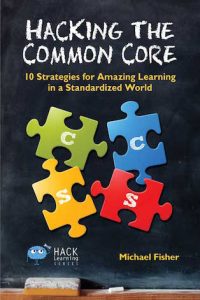Have a Summer of Fun Reading & Writing with Kids
 By Mike Fisher
By Mike Fisher
Now that we are all fully heading into the summer, I thought it would be a good time to talk about summer reading and writing and how to get kids to continue with their literacy efforts over their break.
Over the weekend, we had a great #HackLearning chat on Twitter (Sunday’s at 8:30 AM) on promoting summer reading, and a lot of great ideas were shared. In the interest of expanding that conversation, I’d like to share a few ideas to help parents and teachers #HackSummerLearning!
The best thing that teachers can encourage their students (and parents) to do over the summer is to simply read and write. Kids can read anything of interest, preferably at an instructional level (which might necessitate teachers sharing reading level information with parents). Teachers can then encourage parents to have a daily or every-other-day reading habit.
A pleasure, not a chore

Or even better, leverage social media to replace the reading log and have students and parents tweet to a teacher or school-specific hashtag sharing their favorite moments, titles of books, plot twists, favorite characters – anything!
Don’t make the reading just a student event. Even if the students are older, ask that parents read to their children and have discussions about what’s happening in the books the kids are reading for themselves.
Additionally, summer is a GREAT time to start co-reading events where the parent(s) and the child read the same book and have discussions about happenings and inferences.
Another option is “post mortems” where everybody talks about the book in general. We are doing that this summer with our nine year old. We’ve been waiting years to share Harry Potter with her, and this summer is the summer of Harry for us. My wife and I are so looking forward to sharing this with our daughter and can’t wait to rediscover “the magic!”
Ways to share writing
With writing, teachers can encourage journaling activities, descriptions of summer happenings and events, and/or activities like a sentence-a-day story, where kids write one sentence each day and develop a story that takes weeks to create.
In fact, everybody in the family could participate. Perhaps each person’s sentence contributions are a secret until the next day, when they are shared before new sentences are added.
Another thing that we do with some of our friends that have young kids is to take “writing field trips.” We pick a unique place, pack some snacks and towels, some paper and pens/pencils, and hit the road. We’ve been to the Niagara Gorge, several local parks, Lake Erie, and more, and the kids can write whatever is on their minds or they can write about what they see.
We do this for 20-30 minutes, have a snack, then write for 20-30 more minutes, and then the kids can share some of what they wrote. We’ll be doing that again this summer. (Some of the younger kids go too and spend their time drawing and explaining their drawings during share time.)

A couple of these ideas were previously shared in a blog at Learning First Alliance. What are some ideas you have for fun summer reading and writing? And for further thought: How can schools use social media to promote reading during summer months?
(Feature image: Trung Phan from Pixabay)
________































